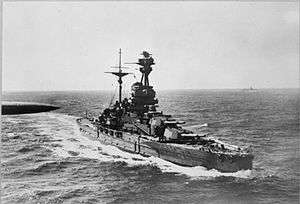1st Battle Squadron (United Kingdom)
| 1st Battle Squadron | |
|---|---|
| Active | 1912–1945 |
| Country |
|
| Branch |
|
| Size | Squadron |

The British 1st Battle Squadron was a naval squadron consisting of battleships. The 1st Battle Squadron was initially part of the Royal Navy's Grand Fleet. After World War I the Grand Fleet was reverted to its original name, the Atlantic Fleet. The squadron changed composition often as ships were damaged, retired or transferred.
History
First World War
As an element in the Grand Fleet, the Squadron participated in the Battle of Jutland.[1]
August 1914
On 5 August 1914, the squadron was constituted as follows:[2]
- HMS Marlborough
- HMS Collingwood
- HMS Colossus
- HMS Hercules
- HMS Neptune
- HMS St. Vincent
- HMS Superb
- HMS Vanguard
Battle of Jutland, June 1916
During the Battle of Jutland, the composition of the 1st Battle Squadron was as follows:[1]
- Sixth Division
- HMS Marlborough Flagship of Vice-Admiral Sir Cecil Burney; Captain G. P. Ross;
- HMS Revenge Captain E. B. Kiddle;
- HMS Hercules Captain L. Clinton-Baker;
- HMS Agincourt Captain H. M. Doughty;
- Fifth Division
- HMS Colossus Flagship of Rear Admiral E. F. A. Gaunt; Captain A. D. P. R. Pound;
- HMS Collingwood Captain J. C. Ley;
- HMS St. Vincent Captain W. W. Fisher;
- HMS Neptune Captain V. H. G. Bernard;
1917 and 1918
Following the Battle of Jutland, the 1st Battle Squadron was reorganized, with Colossus, Hercules, St. Vincent, Collingwood and Neptune all transferred to the 4th Battle Squadron. In January 1917, the squadron was constituted as follows:[3]
- HMS Marlborough
- HMS Agincourt
- HMS Benbow – Joined July,1916
- HMS Canada
- HMS Emperor of India – Joined July, 1916
- HMS Revenge
- HMS Royal Oak – Joined May, 1916
- HMS Royal Sovereign – Joined June, 1916
By 1918, Agincourt had been transferred to the 2nd Battle Squadron, and Resolution, Ramillies and Iron Duke had joined the squadron on completion.[4]
Second World War
For many years the squadron served in the Mediterranean as the main British battle force there. On 3 September 1939 the 1st Battle Squadron, serving in the Mediterranean Fleet, consisted of Barham, Warspite, and Malaya, with headquarters at Alexandria, Egypt, under the command of Vice-Admiral Geoffrey Layton.[5]
In December 1943 the Squadron was under the command of Vice Admiral Arthur Power. In January 1944 the Eastern Fleet was reinforced by HMS Queen Elizabeth, HMS Renown, HMS Valiant, HMS Illustrious, HMS Unicorn, and seven destroyers. The Admiralty sent this force out to India under the title of the First Battle Squadron.[6]
From November 1944, the squadron served in the British Pacific Fleet under the command of Vice-Admiral Henry Rawlings, who also serviced as Second-in-Command of the Fleet. It consisted of HMS King George V, HMS Howe, HMS Duke of York, and HMS Anson at various times.
Commanders
Commanders were as follows:[7]
- Vice-Admiral Sir Stanley Colville (1912–14)
- Vice-Admiral Sir Lewis Bayly (June–December 1914)
- Admiral Sir Cecil Burney (1914–16)
- Vice-Admiral Sir Charles Madden (1916–19)
- Vice-Admiral Sir Sydney Fremantle (1919–21)
- Vice-Admiral Sir William Nicholson (1921–22)
- Vice-Admiral Sir Edwyn Alexander-Sinclair (1922–24)
- Rear-Admiral William Fisher (1924–25)
- Rear-Admiral Cecil Staveley (1925–26)
- Vice-Admiral Sir Michael Hodges (1926–27)
- Vice-Admiral Sir John Kelly (1927–29)
- Vice-Admiral Howard Kelly (1929–30)
- Vice-Admiral Sir Wiliam Fisher (1930–32)
- Vice-Admiral Sir Roger Backhouse (1932–34)
- Vice-Admiral Sir Charles Forbes (1934–36)
- Vice-Admiral Hugh Binney (1936–38)
- Rear-Admiral Ralph Leatham (1938–39)
- Vice-Admiral Geoffrey Layton (January–November 1939)
- Rear-Admiral Henry Pridham-Wippell (July–October 1940)
- Vice-Admiral John Tovey (October–December 1940)
- Rear-Admiral Bernard Rawlings (1940–41)
- Vice-Admiral Sir Henry Pridham-Wippell (1941–42)
- Vice-Admiral Sir Arthur Power (1943–44)
- Vice-Admiral Sir Bernard Rawlings (1944–45)
References
- 1 2 Macintyre, Donald. Jutland Evans Brothers Ltd. 1957; ISBN 0-330-20142-5
- ↑ Dittmar, F.J & Colledge J.J., British Warships 1914–1919 Ian Allan, London. 1972; ISBN 0-7110-0380-7
- ↑ Dittmar, F.J & Colledge J.J., British Warships 1914–1919 Ian Allan, London. 1972; ISBN 0-7110-0380-7 pp20
- ↑ Dittmar, F.J & Colledge J.J., British Warships 1914–1919 Ian Allan, London. 1972; ISBN 0-7110-0380-7 pp24
- ↑ Orbat.com/Niehorster, Mediterranean Fleet, 3 September 1939, accessed May 2008
- ↑ Jackson, Ashley (2006). The British Empire and the Second World War. Continuum International Publishing Group. p. 301. ISBN 1-85285-417-0.
- ↑ "Royal Navy Senior Appointments" (PDF). Retrieved 4 October 2014.